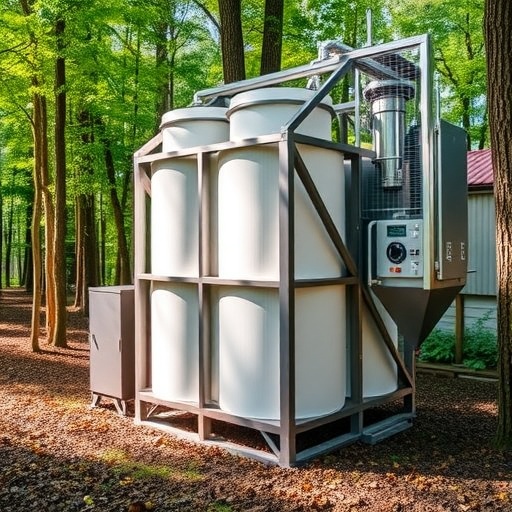In an era where air pollution poses an increasingly grave threat to public health and the environment, innovations in filtration technology have become paramount. Addressing the challenge of effectively removing ultrafine particulate matter (PM₀.₃) from the air, a team of researchers led by Wang et al. has unveiled a groundbreaking sustainable biomass-based filter with exceptional efficacy. Published in Nature Communications, this pioneering work not only highlights a novel approach to air purification but also underscores the potential for eco-friendly materials to revolutionize the field.
Ultrafine particulate matter, particularly particles with diameters of 0.3 micrometers or smaller, presents a significant health risk due to their ability to penetrate deep into the respiratory system and even enter the bloodstream. Traditional filtration systems, especially those based on synthetic materials, often face trade-offs between filtration efficiency, airflow resistance, and environmental impact. Wang and colleagues tackled this complex problem by developing a filter derived from naturally abundant biomass, thereby aligning high-performance air purification with principles of sustainability.
The innovation hinges on the unique structural and chemical properties of biomass materials, which allow for highly efficient capture of PM₀.₃ particles without imposing excessive pressure drops that hinder airflow. By employing a meticulous fabrication process, the researchers transformed biomass into a fibrous network with hierarchical porosity, optimizing the balance between particle interception and breathability. This ensures that the filter performs excellently without compromising comfort when used in personal respiratory protective equipment or indoor air filtration devices.
A critical technical advancement reported in the study involves the integration of functional groups onto the biomass filter fibers that enhance particle capture through electrostatic attraction and van der Waals forces. The presence of these functional moieties increases particle retention rates, especially for the most challenging ultrafine particles, which typically evade mechanical interception. This dual mechanism—physical sieving complemented by chemical affinity—marks a significant leap from purely mechanical filters.
Moreover, the production methods employed are designed to be scalable and cost-effective. Using readily accessible raw materials such as agricultural residues or other lignocellulosic biomass, Wang’s team demonstrated that it is feasible to mass-produce these filters without the environmental footprint commonly associated with synthetic polymer manufacturing. The process leverages eco-friendly techniques, including mild chemical treatments and environmentally benign drying methods, aligning the overall lifecycle of the product with green chemistry principles.
Experimental validation using standardized testing environments revealed that the biomass-based filters achieved filtration efficiencies exceeding 99% for PM₀.₃ particles. Notably, these impressive results were attained at airflow velocities relevant to practical applications, ensuring that the filters maintain their performance in real-world conditions. Comparative analyses showed that the biomass filters outperformed many commercially available synthetic filters, positioning them as a competitive, yet sustainable alternative.
Beyond filtration efficiency, the study explored the durability and mechanical robustness of the biomass filters. Unlike many natural materials that degrade rapidly when exposed to moisture or repeated handling, the engineered filters retained their structural integrity over extended periods. This longevity is crucial for practical deployment, reducing the frequency of replacement and thereby decreasing the waste generated by disposable filters.
The researchers also investigated the environmental impact of the filter both at the production and end-of-life stages. Life cycle assessments indicated that the biomass filters have significantly lower carbon footprints and generate minimal harmful byproducts relative to conventional filters crafted from petroleum-derived polymers. In addition, the complete biodegradability of the filter materials opens avenues for environmentally responsible disposal methods, mitigating the persistent issue of plastic pollution linked to air filtration waste.
Delving into the dynamics of filtration at the microscopic level, the team utilized advanced imaging techniques and computational modeling to understand how particles interact with the fibrous matrix. These analyses revealed that the hierarchical pore structure not only improves capture efficiency but also ensures uniform distribution of airflow, preventing clogging and maintaining consistent performance. Such insights provide a foundation for further refinements and tailor-made filter designs catering to diverse environments.
The implications of this research extend beyond individual protection against air pollution. Urban centers worldwide struggle with elevated levels of ultrafine particulate matter stemming from traffic, industrial emissions, and other anthropogenic sources. Deploying sustainable, high-efficiency filters at scale in HVAC systems, public transportation, and wearable devices could drastically reduce exposure to harmful pollutants, thereby improving public health outcomes at the population level.
In the context of global climate goals and sustainable development, this innovation aligns seamlessly with broader environmental and societal objectives. As nations strive to minimize waste and reduce dependency on fossil-based products, the adoption of biomass-derived materials for critical applications such as air filtration represents a strategic intersection of health and sustainability imperatives.
The research also opens intriguing possibilities for multifunctionality. Given the inherent chemical versatility of biomass, future iterations of such filters could incorporate catalytic or antimicrobial functionalities, adding layers of protection against pathogens and chemical pollutants without compromising environmental compatibility. This adaptability enhances the potential impact of biomass-based filtration technologies across an array of sectors.
While the initial results are remarkably promising, Wang et al. acknowledge that further research is necessary to optimize manufacturing protocols, scale-up processes, and validate long-term field performance under varying environmental conditions. Nonetheless, their work establishes a robust foundation for next-generation air filtration materials that harmonize human health imperatives with sustainability commitments.
In conclusion, the sustainable biomass-based filter developed by Wang and colleagues represents a pivotal advancement in air filtration technology. It elegantly addresses the persistent challenge of capturing the most hazardous PM₀.₃ particles while mitigating environmental concerns associated with synthetic filter materials. As air quality emerges as a defining health and environmental challenge of our time, such innovations offer hope and tangible solutions to improve the air we breathe—supporting healthier communities and a cleaner planet.
Subject of Research: Ultrafine particulate matter filtration using biomass-derived sustainable materials.
Article Title: Sustainable biomass-based filter for high-efficiency PM₀.₃ filtration.
Article References:
Wang, Q., Niu, Z., Cheng, W. et al. Sustainable biomass-based filter for high-efficiency PM₀.₃ filtration. Nat Commun 16, 6596 (2025). https://doi.org/10.1038/s41467-025-61863-2
Image Credits: AI Generated




